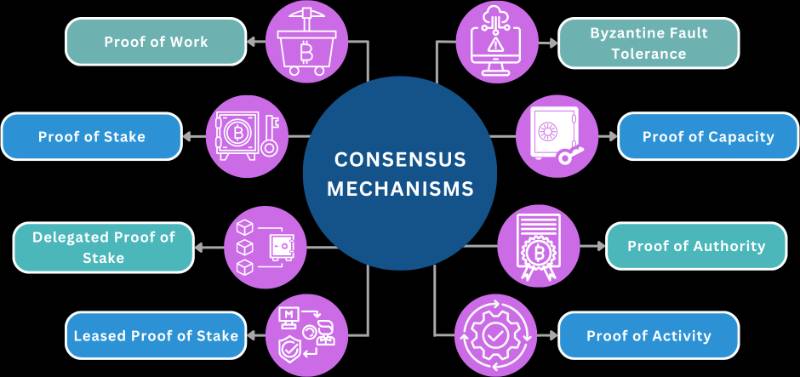1. Introduction & Overview
What is a Consensus Mechanism?

A consensus mechanism is the algorithmic protocol that ensures all participants in a distributed ledger or blockchain agree on the current state of the network. In simple terms, it’s how multiple computers (nodes) reach agreement on which transactions are valid without relying on a central authority.
- In centralized finance: banks validate and authorize transactions.
- In cryptoblockcoins: consensus mechanisms replace banks with decentralized rules.
This ensures:
- No double-spending of coins.
- Fair ordering of transactions.
- Security against malicious actors.
History & Background
- 1990s: Byzantine Generals Problem (theory on distributed trust).
- 2008: Bitcoin introduced Proof of Work (PoW).
- 2011–2015: Variations like Proof of Stake (PoS) and Delegated PoS (DPoS).
- 2020+: Modern mechanisms like Proof of Authority (PoA), Proof of History (PoH), and hybrid consensus.
Why is it Relevant in Cryptoblockcoins?
Without consensus, blockchain becomes chaos. Consensus is the invisible referee that guarantees fairness, security, and scalability.
2. Core Concepts & Terminology
| Term | Definition | Example in Context |
|---|---|---|
| Node | A participant in the network (validator, miner). | A Bitcoin miner verifying blocks. |
| Ledger | Distributed database recording transactions. | Blockchain. |
| Block | A group of validated transactions. | 1MB Bitcoin block. |
| Fork | Divergence in blockchain history. | Bitcoin vs Bitcoin Cash. |
| Finality | Guarantee that a block cannot be reversed. | PoS offers faster finality vs PoW. |
Role in Cryptoblockcoin Lifecycle
- Transaction created → sent to network.
- Nodes validate transaction.
- Consensus mechanism decides ordering and approval.
- Block is added to chain.
- Immutable record is shared across all participants.
3. Architecture & How It Works
Components
- Transaction Pool: Pending transactions.
- Consensus Layer: Algorithm (PoW, PoS, etc.).
- Block Proposal: Node suggests new block.
- Validation: Other nodes verify correctness.
- Finalization: Block accepted, chain updated.
Internal Workflow
- A transaction is broadcast.
- Consensus mechanism selects a validator (miner/staker).
- Validator proposes block.
- Other validators verify.
- Consensus achieved → block added.
Text-Based Architecture Diagram
+-------------------------+
| Transaction Requests |
+-----------+-------------+
|
v
+-------------------------+
| Transaction Pool |
+-----------+-------------+
|
v
+-------------------------+
| Consensus Mechanism |
| (PoW, PoS, etc.) |
+-----------+-------------+
|
+--------+---------+
| |
v v
Block Proposal Block Validation
| |
+--------+---------+
|
v
+-------------------------+
| Block Finalization |
+-------------------------+
|
v
+-------------------------+
| Distributed Ledger |
+-------------------------+
Integration with CI/CD or Cloud Tools
- Consensus nodes can be containerized (Docker).
- Kubernetes clusters deploy validators for high availability.
- CI/CD pipelines push smart contract updates, tested on private testnets.
4. Installation & Getting Started
Prerequisites
- Node.js, Python, or Go (depending on chain).
- Docker & Kubernetes (for scalable deployment).
- Cloud provider (AWS/GCP/Azure).
Beginner-Friendly Setup Example (Proof of Stake Testnet)
# Clone a PoS blockchain repo (example: Ethereum client)
git clone https://github.com/ethereum/go-ethereum
cd go-ethereum
# Build and run node
make geth
./build/bin/geth --goerli --http --syncmode=light
This connects to the Goerli Ethereum testnet where PoS consensus is active.
5. Real-World Use Cases
Scenarios
- Bitcoin (BTC) → Proof of Work, secure but energy heavy.
- Ethereum 2.0 (ETH) → Proof of Stake, scalable and energy efficient.
- Solana (SOL) → Proof of History, fast throughput.
- EOS (EOSIO) → Delegated Proof of Stake, enterprise adoption.
Industry-Specific Examples
- Finance: Settling cross-border payments.
- Supply Chain: Tracking goods provenance.
- Healthcare: Securing patient data.
- Voting: Transparent and tamper-proof elections.
6. Benefits & Limitations
| Benefit | Limitation |
|---|---|
| Decentralization (no central authority). | Energy consumption (PoW). |
| Security through cryptography. | Risk of cartelization (DPoS). |
| Transparency and immutability. | Slower than centralized systems. |
| Censorship resistance. | Some mechanisms lack scalability. |
7. Best Practices & Recommendations
- Security Tips:
- Regularly update validator software.
- Use multi-signature wallets for rewards.
- Isolate consensus nodes from external APIs.
- Performance & Maintenance:
- Deploy nodes on high-uptime cloud infra.
- Monitor block finality with alerting tools.
- Compliance Alignment:
- GDPR-compliant storage of user data.
- KYC/AML frameworks for enterprise chains.
- Automation Ideas:
- CI/CD smart contract pipelines.
- Automated slashing detection scripts.
8. Comparison with Alternatives
| Mechanism | Speed | Energy Use | Security | Examples |
|---|---|---|---|---|
| PoW | Slow | High | Very High | Bitcoin |
| PoS | Medium | Low | High | Ethereum 2.0 |
| DPoS | Fast | Low | Moderate | EOS |
| PoH | Very Fast | Low | High | Solana |
| PoA | Fast | Low | Medium | VeChain |
When to Choose
- PoW: When maximum security is priority.
- PoS: Balanced energy and scalability.
- DPoS: Fast decisions, enterprise-grade.
- PoH: High throughput use cases (DeFi).
9. Conclusion
Consensus mechanisms are the heartbeat of cryptoblockcoins. They solve trust issues without central authority, balancing decentralization, security, and performance.
Future Trends
- Hybrid consensus models (PoW + PoS).
- Green consensus (energy-efficient).
- AI-assisted consensus optimization.
Next Steps
- Experiment on Ethereum Goerli or Solana devnet.
- Contribute to open-source blockchain repos.
- Follow research at Hyperledger and Ethereum Foundation.
Official Resources:
- Ethereum Consensus Docs
- Hyperledger
- Solana Consensus